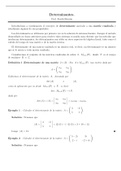Samenvatting
Sumario Determinantes
- Vak
- Instelling
- Boek
Los determinantes se utilizaron por primera vez en la solución de sistemas lineales. Aunque el método desarrollado en clases anteriores para resolver tales sistemas es mucho más eficiente que los métodos que involucran determinantes, los determinantes son útiles en otros aspectos del álgebra ...
[Meer zien]





